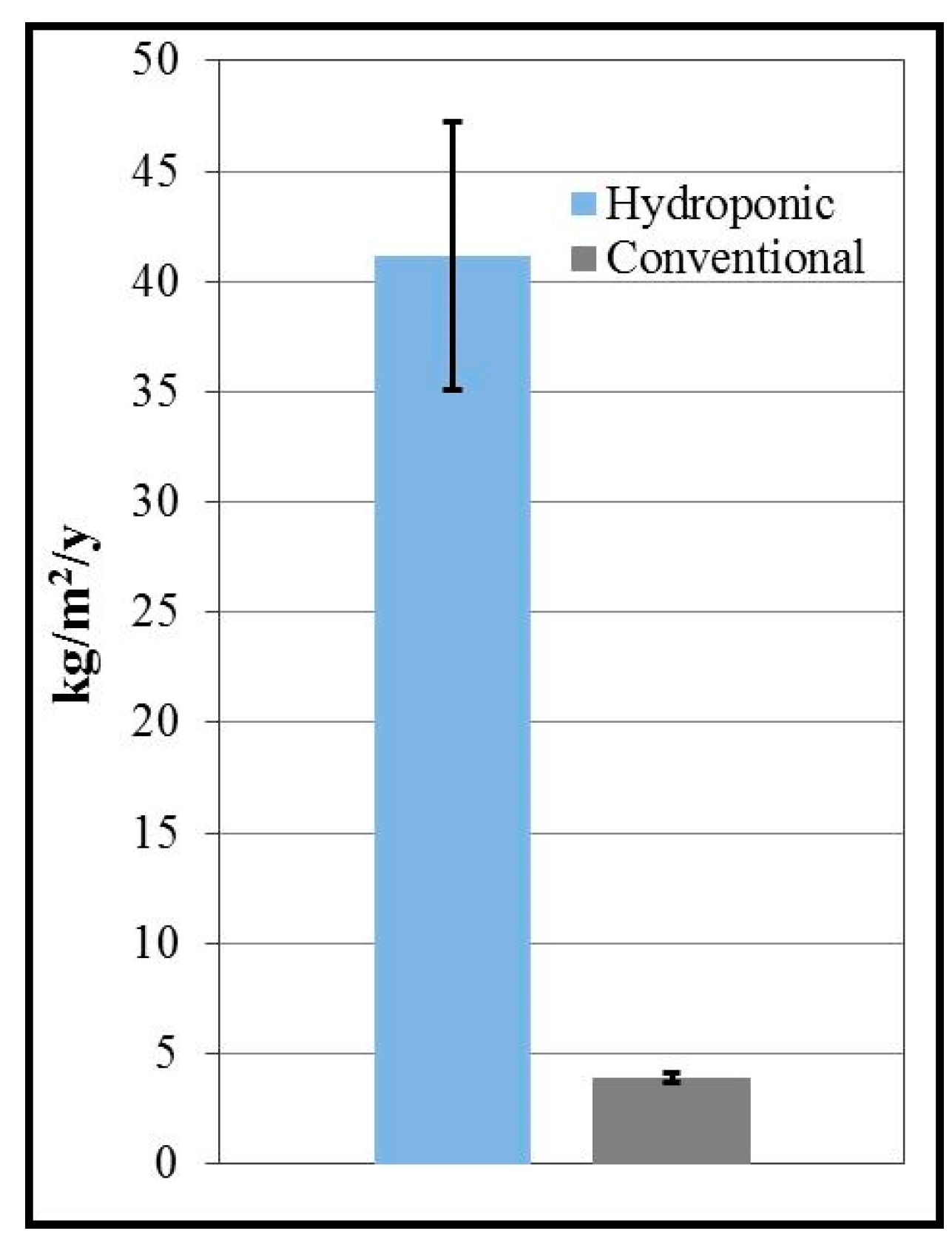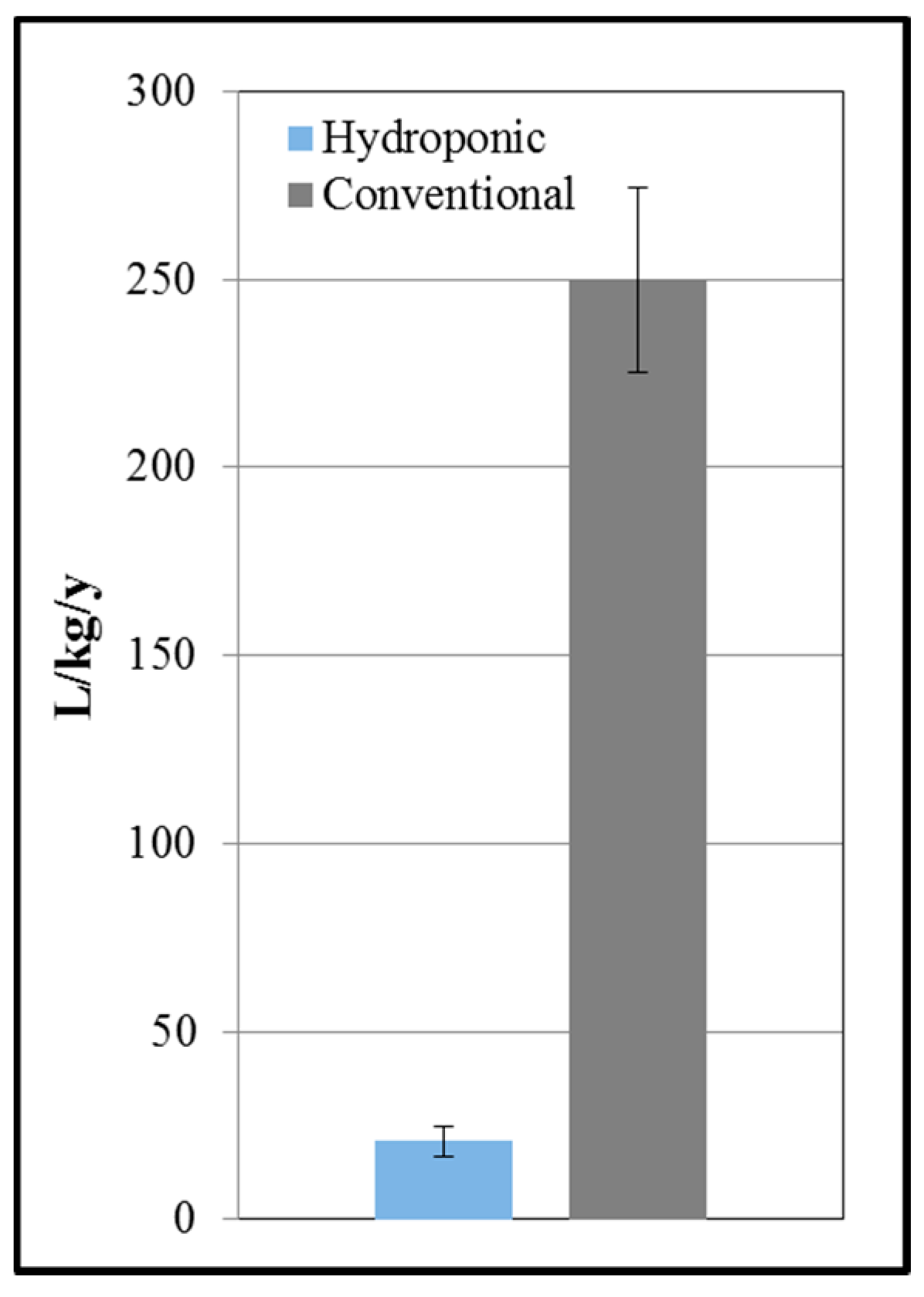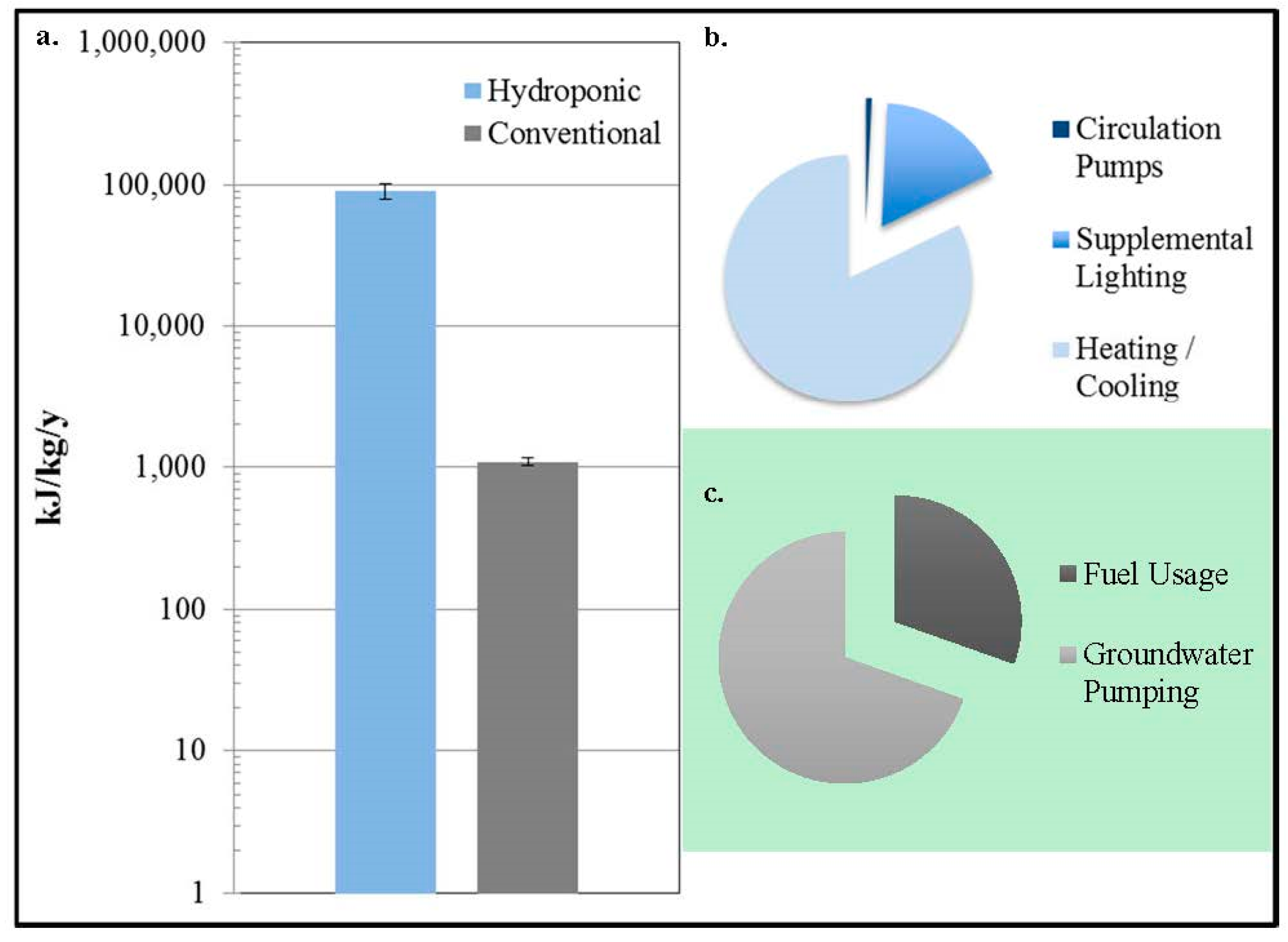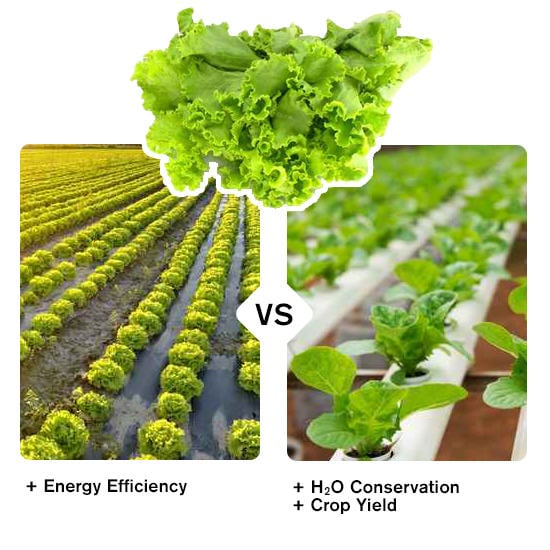Comparison of Land, Water, and Energy Requirements of Lettuce Grown Using Hydroponic vs. Conventional Agricultural Methods
Abstract
:1. Introduction
2. Experimental Section
2.1. Lettuce Grown Using Conventional Agricultural Methods
2.1.1. Conventional Yield
2.1.2. Conventional Water Usage
2.1.3. Conventional Energy Usage
2.2. Lettuce Grown Using Hydroponic Methods
2.2.1. Hydroponic Yield
2.2.2. Hydroponic Water Usage
2.2.3. Hydroponic Energy Usage
- E: Energy per mole of photons (J/mol)
- h: Planck’s constant (6.626 × 10−34 J·s)
- c: Speed of light (2.998 × 108 m/s)
- λ: Wavelength of light (m)
- Q: Heat lost or gained due to outside temperature (kJ·h−1)
- U: Overall heat transfer coefficient (kJ·h−1·m−2·°C−1)
- SA: Surface area of greenhouse (m2)
- Tin: Inside air set point temperature (°C)
- Tout: Outside air temperature (°C)
3. Results and Discussion



| Production Method | Yield (kg/m2/y) | Water Use (L/kg/y) | Energy Use (kJ/kg/y) | |||
|---|---|---|---|---|---|---|
| Value | S.D. | Value | S.D. | Value | S.D. | |
| Conventional | 3.9 | 0.21 | 250 | 25 | 1100 | 75 |
| Hydroponics | 41 | 6.1 | 20 | 3.8 | 90,000 | 11,000 |
| Month | January | February | March | April | May | June | July | August | September | October | November | December |
|---|---|---|---|---|---|---|---|---|---|---|---|---|
| Average Temperature (°C) | 14.8 | 16.6 | 19.6 | 22.8 | 27.4 | 31.7 | 34.7 | 34.6 | 31.7 | 25.3 | 18.7 | 14.1 |
| Percent Energy Demand | 12% | 8% | 6% | 1% | 5% | 10% | 14% | 14% | 10% | 2% | 6% | 13% |
4. Conclusions
Acknowledgments
Author Contributions
Conflicts of Interest
References
- Killebrew, K.; Wolff, H. Environmental Impacts of Agricultural Technologies. Evans School of Public Affairs. University of Washington. Available online: http://econ.washington.edu/files/2014/06/2010-Environmental-Impacts-of-Ag-Technologies.pdf (accessed on 1 December 2014).
- Walls, M. Agriculture and Environment. MTT Agrifood Research Finland. Available online: http://ec.europa.eu/research/agriculture/scar/pdf/scar_foresight_environment_en.pdf (accessed on 1 December 2014).
- Sacks, W.J. Crop Calendar Dataset. Center for Sustainability and the Global Environment. University of Wisconsin-Madison. Available online: http://www.sage.wisc.edu/download/sacks/crop_calendar.html (accessed on 1 December 2014).
- World Water Assessment Programme (WWAP). The United Nations World Water Development Report 3: Water in a Changing World; UNESCO: Paris, France; London, UK; Earthscan, UK, 2009. [Google Scholar]
- Brechner, M.; Both, A.J. Hydroponic Lettuce Handbook. Cornell Controlled Environment Agriculture; Cornell University. Available online: http://www.cornellcea.com/attachments/Cornell CEA Lettuce Handbook.pdf (accessed on 2 December 2014).
- Tognoni, F.; Pardossi, A. Chapter 15: Soil-less Culture for Greenhouse Crops in the Mediterranean Countries. Methyl Bromide Alternatives for North African and Southern European Countries. United Nations Publication. Available online: http://www.unep.fr/ozonaction/information/mmcfiles/3204-e.pdf (accessed on 30 January 2015).
- Albright, L.D.; Langhans, R.W. Controlled Environmental Agriculture Scoping Study. Controlled Environment Agriculture Program, Cornell University. Available online: http://www.cornellcea.com/attachments/Controlled%20Environment%20Agriculture%20Scoping%20Study%20pdf%20-%20Adobe%20Acrobat%20Professional.pdf (accessed on 11 November 2014).
- USDA. Vegetables 2013 Summary. National Agricultural Statistics Service. Available online: http://usda.mannlib.cornell.edu/usda/nass/VegeSumm//2010s/2014/VegeSumm-03-27-2014.pdf (accessed on 1 November 2014).
- Kerns, D.L.; Matheron, M.E.; Palumbo, J.C.; Sanchez, C.A.; Still, D.W.; Tickes, B.R.; Umeda, K.; Wilcox, M.A. Guidelines for Head Lettuce Production in Arizona. Cooperative Extension, College of Agriculture and Life Sciences, University of Arizona, Tucson, Arizona, IPM Series 12(AZ1099). Available online: http://cals.arizona.edu/crops/vegetables/cropmgt/az1099.html (accessed on 11 November 2014).
- Arizona Department of Water Resources (ADWR). Arizona’s Water Supply and Demand. Available online: http://www.azwater.gov/AzDWR/PublicInformationOfficer/documents/supplydemand.pdf (accessed on 25 November 2014).
- Teegerstrom, T.; Palumbo, J.; Zerkoune, M. 2001–2002 Arizona Vegetable Crop Budgets, Western Arizona, Yuma County, La Paz County; Cooperative Extension, College of Agriculture and Life Sciences, University of Arizona, Tucson, Arizona, (AZ1263). Available online: http://extension.arizona.edu/sites/extension.arizona.edu/files/pubs/az1263.pdf (accessed on 11 November 2014).
- Acker, T.; Atwater, C.; French, W.; Glauth, M.; Smith, D. Energy and Water Use in Arizona Agriculture, Working Paper 08–08. Available online: http://franke.nau.edu/images/uploads/fcb/08-08.pdf (accessed on 30 April 2015).
- Donnell, M.; Short, T.; Moore, R.; Draper, C. Hydroponic Greenhouse Lettuce Enterprise Budget; Hydroponic Program Team, Ohio State University: Ohio, OH, USA, 2011. [Google Scholar]
- Both, A.J. Dynamic Simulation of Supplemental Lighting for Greenhouse Hydroponic Lettuce Production. Ph.D. Thesis, Cornell University Libraries, Ithaca, NY, USA, 1995. [Google Scholar]
- Lopes da Luz, G.; Petter Medeiros, S.; Manfron, P.; Borcioni, E.; Muller, L.; Dischkaln do Amaral, A.; Pereira Morais, K. Consumo de energia elétrica e produção de alface hidropônica com três intervalos entre irrigações. Ciênc. Rural 2008, 38, 815–818. [Google Scholar]
- USDA. U.S. Lettuce Statistics. Table 6. Economic, Statistics, and Market Information System, Economic Research Service. Available online: http://usda.mannlib.cornell.edu/MannUsda/viewDocumentInfo.do?documentID=1576 (accessed on 11 November 2014).
- USDA. Vegetables 2010 Summary. National Agricultural Statistics Service. Available online: http://usda.mannlib.cornell.edu/usda/nass/VegeSumm/2010s/2011/VegeSumm-01-27-2011.pdf (accessed on 1 November 2014).
- USDA. Vegetables 2011 Summary. National Agricultural Statistics Service. Available online: http://usda.mannlib.cornell.edu/usda/nass/VegeSumm//2010s/2012/VegeSumm-01-26-2012.pdf (accessed on 1 November 2014).
- USDA. Vegetables 2012 Summary. National Agricultural Statistics Service. Available online: http://usda.mannlib.cornell.edu/usda/nass/VegeSumm//2010s/2013/VegeSumm-01-29-2013.pdf (accessed on 1 November 2014).
- Coolong, T. Hydroponic Lettuce. Cooperative Extension Service, College of Agriculture, University of Kentucky. Available online: http://www.uky.edu/Ag/CCD/introsheets/hydrolettuce.pdf (accessed on 11 November 2014).
- Jensen, M.H. Deep flow hydroponics—Past, present and future. Available online: http://ag.arizona.edu/ceac/sites/ag.arizona.edu.ceac/files/Deep%20flow%20hydroponics%20merle%20jensen_0.pdf (accessed on 30 April 2015).
- Both, A.J. Ten Years of Hydroponic Lettuce Research. Available online: http://www.researchgate.net/publication/266453402_TEN_YEARS_OF_HYDROPONIC_LETTUCE_RESEARCH (accessed on 12 June 2015).
- Geromel, N. Técnicas de Hidroponia. Geronet Services. Available online: http://www.bonscursos.com/down/agropecuaria/hidroponia.pdf (accessed on 26 October 2014).
- Giacomelli, A.G. Considerations for Energy Management of Greenhouse Heating and Cooling.” Southern Greenhouse Vegetable Growers Association Conference (2002). Available online: http://ag.arizona.edu/ceac/sites/ag.arizona.edu.ceac/files/Considerations for Energy Management of Greenhouse Heating a.pdf (accessed on 2 December 2014).
- National Weather Service—Yuma Area. In National Weather Service; The United States Government. Available online: http://www.nws.noaa.gov/climate/xmacis.php?wfo=psr (accessed on 6 November 2014).
- Sanchez, S.V. Avaliação de alface crespa produzidas em hidropônia tipo NFT em dois ambientes protegidos em Ribeirão Preto (SP). Paulista State University, College of Agricultural and Veterinary Science. Available online: http://www.fcav.unesp.br/download/pgtrabs/pv/m/2802.pdf (accessed on 9 September 2014).
- Martineau, V.; Lefsrud, M.; Naznin, M.T.; Kopsell, D.A. Comparison of light-emitting diode and high-pressure sodium light treatments for hydroponics growth of Boston lettuce. Hortscience 2012, 47, 477–482. [Google Scholar]
- Zhou, W.L.; Liu, W.K.; Yang, Q.C. Quality changes in hydroponic lettuce grown under pre-harvest short-duration continuous light of different intensities. J. Hortic. Sci. Biotechnol. 2012, 87, 429–434. [Google Scholar]
- National Renewable Energy Laboratory. Photovoltaic Solar Resource: Flat Plate Titled South at Latitude. Annual. Map. Available online: http://www.nrel.gov/gis/images/map_pv_us_annual10km_dec2008.jpg (accessed on 2 June 2015).
- Food and Agriculture Organization of the United Nations. Popular Hydroponic Gardens. Technical Manual. Audio Visual Course. Available online: https://d3gxp3iknbs7bs.cloudfront.net/attachments/d9f87093ecb633dac0891234f03989a1179eaf9.pdf (accessed on 2 June 2015).
© 2015 by the authors; licensee MDPI, Basel, Switzerland. This article is an open access article distributed under the terms and conditions of the Creative Commons Attribution license (http://creativecommons.org/licenses/by/4.0/).
Share and Cite
Barbosa, G.L.; Gadelha, F.D.A.; Kublik, N.; Proctor, A.; Reichelm, L.; Weissinger, E.; Wohlleb, G.M.; Halden, R.U. Comparison of Land, Water, and Energy Requirements of Lettuce Grown Using Hydroponic vs. Conventional Agricultural Methods. Int. J. Environ. Res. Public Health 2015, 12, 6879-6891. https://doi.org/10.3390/ijerph120606879
Barbosa GL, Gadelha FDA, Kublik N, Proctor A, Reichelm L, Weissinger E, Wohlleb GM, Halden RU. Comparison of Land, Water, and Energy Requirements of Lettuce Grown Using Hydroponic vs. Conventional Agricultural Methods. International Journal of Environmental Research and Public Health. 2015; 12(6):6879-6891. https://doi.org/10.3390/ijerph120606879
Chicago/Turabian StyleBarbosa, Guilherme Lages, Francisca Daiane Almeida Gadelha, Natalya Kublik, Alan Proctor, Lucas Reichelm, Emily Weissinger, Gregory M. Wohlleb, and Rolf U. Halden. 2015. "Comparison of Land, Water, and Energy Requirements of Lettuce Grown Using Hydroponic vs. Conventional Agricultural Methods" International Journal of Environmental Research and Public Health 12, no. 6: 6879-6891. https://doi.org/10.3390/ijerph120606879
APA StyleBarbosa, G. L., Gadelha, F. D. A., Kublik, N., Proctor, A., Reichelm, L., Weissinger, E., Wohlleb, G. M., & Halden, R. U. (2015). Comparison of Land, Water, and Energy Requirements of Lettuce Grown Using Hydroponic vs. Conventional Agricultural Methods. International Journal of Environmental Research and Public Health, 12(6), 6879-6891. https://doi.org/10.3390/ijerph120606879








